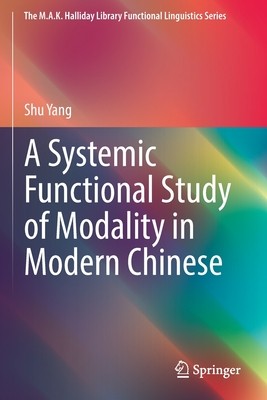
- We will send in 10–14 business days.
- SAVE -10% with code: EXTRA
A Systemic Functional Study of Modality in Modern Chinese (e-book) (used book) | bookbook.eu
Reviews
Description
1 Introduction1.1 Preamble
1.2 Background to the research
1.3 Theoretical framework
1.4 Research questions1.5 Data and methodology
1.6 The organization of the book
2 Literature Review
2.1 Introduction
2.2 Modality in English
2.3 Modality in Modern Chinese
2.4 Modality in SFL
2.4.1 Halliday (1985, 1994); Halliday & Matthiessen (2014)2.4.2 Thompson (1996, 2004, 2013)
2.4.3 Martin (1990, 1992); Martin & White (2005); Martin & Rose (2007)
2.4.4 Fawcett (2008, forthcoming)
2.4.5 Zhu (1985, 1996); Halliday & McDonald (2004); Li (2007)
3 Systemic Functional Theory Revisited
3.1 Introduction
3.2 SFL as a general linguistic theory3.3 The "architecture" of language
3.3.1 Stratification
3.3.2 Instantiation
3.3.3 Metafunction
3.3.4 Axis (paradigmatic organization)
3.3.5 Axis (syntagmatic organization)
3.3.6 Rank
3.4 Reasons for adopting the systemic functional approach
3.5 Summary
4 A Short Overview of Chinese Lexicogrammar
4.1 Introduction
4.2 Interpersonal meaning - the system of MOOD
4.3 Experiential meaning - the system of TRANSITIVITY
4.4 Textual meaning - the system of THEME and INFORMATION
4.5 Logical meaning - the systems of TAXIS and LOGICO-SEMANTIC TYPES
5 The System of Types of Modality
5.1 Introduction
5.2 Two major types of modality5.3 Modulation
5.3.1 Obligation
5.3.2 Inclination
5.3.3 Ability5.4 Modalization: probability
5.4.1 Certainty
5.4.2 Median probability
5.4.3 Possibility5.5 Usuality in Chinese
5.6 Summary
6 The System of Realization of Types of Modality
6.1 Introduction
6.2 Modalization: the system of ORIENTATIONS
6.3 Modulation: the system of ORIENTATION
6.4 The notion of "cline"
7 Realizations of Modality in the Textual Structure of Clause
7.1 Introduction
7.2 Realizations of modality in the thematic structure
7.2.1 Modal adverbs of probability as the interpersonaEXTRA 10 % discount with code: EXTRA
The promotion ends in 19d.23:33:56
The discount code is valid when purchasing from 10 €. Discounts do not stack.
- Author: Shu Yang
- Publisher: Springer
- ISBN-10: 9811680221
- ISBN-13: 9789811680229
- Format: 15.6 x 23.4 x 1 cm, softcover
- Language: English English
1.1 Preamble
1.2 Background to the research
1.3 Theoretical framework
1.4 Research questions1.5 Data and methodology
1.6 The organization of the book
2 Literature Review
2.1 Introduction
2.2 Modality in English
2.3 Modality in Modern Chinese
2.4 Modality in SFL
2.4.1 Halliday (1985, 1994); Halliday & Matthiessen (2014)2.4.2 Thompson (1996, 2004, 2013)
2.4.3 Martin (1990, 1992); Martin & White (2005); Martin & Rose (2007)
2.4.4 Fawcett (2008, forthcoming)
2.4.5 Zhu (1985, 1996); Halliday & McDonald (2004); Li (2007)
3 Systemic Functional Theory Revisited
3.1 Introduction
3.2 SFL as a general linguistic theory3.3 The "architecture" of language
3.3.1 Stratification
3.3.2 Instantiation
3.3.3 Metafunction
3.3.4 Axis (paradigmatic organization)
3.3.5 Axis (syntagmatic organization)
3.3.6 Rank
3.4 Reasons for adopting the systemic functional approach
3.5 Summary
4 A Short Overview of Chinese Lexicogrammar
4.1 Introduction
4.2 Interpersonal meaning - the system of MOOD
4.3 Experiential meaning - the system of TRANSITIVITY
4.4 Textual meaning - the system of THEME and INFORMATION
4.5 Logical meaning - the systems of TAXIS and LOGICO-SEMANTIC TYPES
5 The System of Types of Modality
5.1 Introduction
5.2 Two major types of modality5.3 Modulation
5.3.1 Obligation
5.3.2 Inclination
5.3.3 Ability5.4 Modalization: probability
5.4.1 Certainty
5.4.2 Median probability
5.4.3 Possibility5.5 Usuality in Chinese
5.6 Summary
6 The System of Realization of Types of Modality
6.1 Introduction
6.2 Modalization: the system of ORIENTATIONS
6.3 Modulation: the system of ORIENTATION
6.4 The notion of "cline"
7 Realizations of Modality in the Textual Structure of Clause
7.1 Introduction
7.2 Realizations of modality in the thematic structure
7.2.1 Modal adverbs of probability as the interpersona

Reviews